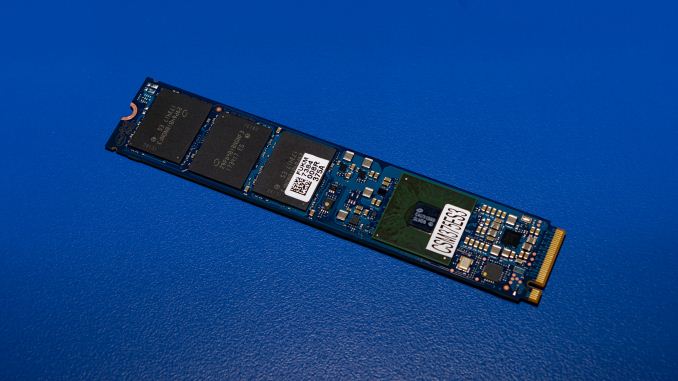Intel Previews Optane Enterprise M.2 SSD
by Billy Tallis on March 21, 2018 7:15 PM EST
At the Open Compute Project Summit this week, Intel previewed their upcoming enterprise Optane SSD in the M.2 form factor, currently planned to be named the Optane SSD DC P4801X.
Intel's current Optane product family includes the flagship Optane SSD DC P4800X in U.2 and PCIe add-in card form factors, the consumer derivative Optane SSD 900P, and the consumer Optane Memory and Optane SSD 800P M.2 drives. The P4800X and 900P are physically big and power-hungry drives while the Optane Memory and 800P use a tiny controller, don't fill the space available on a M.2 2280 card, and have very limited capacity.
The limited performance and capacity of the Optane SSD 800P makes it a poor starting point for an enterprise Optane M.2 drive, but the controller on the P4800X and 900P is too large for an M.2 drive. Intel has previously faced similar challenges with their flash-based enterprise NVMe SSDs being ill-suited for the M.2 form factor, but their second generation controllers produced the low-power SSD DC P4501. Intel has now managed to scale down the packaging of their high-end Optane SSD controller to also fit on a M.2 SSD. The controller on the P4801X uses the same 7-channel architecture as the P4800X and 900P, but peak performance will be lower due to the power and thermal constraints of M.2 drives. The samples at Intel's booth were 375GB drives, matching the introductory capacity of the P4800X by using seven quad-die packages of 3D XPoint memory, where the first P4800X used 28 single-die packages spread across both sides of the half-height half-length add-in card.
This was not a full product announcement, so Intel has not released any performance or power specifications. The OCP Summit is an event focused entirely on datacenter products, so no consumer counterpart was discussed, but it is clear that Intel can easily release a consumer version. This can address the gap between the 118GB Optane SSD 800P M.2 SSD and the 280GB 900P that is only available in U.2 or add-in card form factors.
Source: Intel















15 Comments
View All Comments
IntelUser2000 - Wednesday, March 21, 2018 - link
"This can address the gap between the 118GB Optane SSD 800P M.2 SSD and the 280GB 900P that is only available in U.2 or add-in card form factors."I'm not sure how, maybe you meant something between 280GB and 480GB 900P, because 375GB is surely greater than 280GB.
Because Intel made 900P much cheaper than most expected, and 800P, more expensive than anyone expected, there's little room between the two.
DanNeely - Wednesday, March 21, 2018 - link
It means that they can make a 2xx GB m.2 consumer drive. U.2 is more or less an enterprise form factor and Optane is expensive enough per GB that a 375gb m.2 would be too pricey for most consumers. A 200/250GB drive would split the cost difference while having enough storage capacity to be a lot more comfortable as a primary drive.IntelUser2000 - Thursday, March 22, 2018 - link
Please, Dan. I'm already aware the 900P is available in 280GB capacities, making a 250GB version pointless. The 280GB costs $389.The lower end 800P costs $199 for the 118GB version and has lot less sequential throughput, due to the reads being capped by PCIe x2 interface and writes being capped by having too few channels.
Already, there's the opinion that its better to pay $389 and get the 280GB 900P because at least with 280GB it makes it a usable boot drive, while at 118GB, the 800P is quite small and you end up with lower performance to boot. If Intel made the 118GB cheaper at $149 or so it might have made much more sense on its own.
Zizy - Thursday, March 22, 2018 - link
900P has to be available in M.2 form factor to be useful for consumers, and this is what the P4801X seems to provide. We shall see if it manages to carve a niche.Zan Lynx - Tuesday, March 27, 2018 - link
900P works fine as an add-in card for desktops. Perhaps you meant "laptop users" when you said "consumers."deil - Thursday, March 22, 2018 - link
118 GB drive is good for linux OS, no need for more and Perfect for windows pagefile :)smithronan - Monday, August 19, 2019 - link
Great Post about Tracking Trends. Keep up the good work sir. Thanks for sharing hp error code 0xc0000034 https://www.hpsupportphonenumbers.com/fix-hp-error...rogerdavid4419 - Friday, August 23, 2019 - link
This blog is an year old but I think still it gives enough information which we can use today also but some new models of ssd's have came in market. Visit to fix <a href="https://www.contactemailssupport.com/blog/how-to-b... block email addresses in aol </a>Drazick - Thursday, March 22, 2018 - link
What about a U.2 Interface disk?Those M.2 are too limited in size and thermal performance.
Samus - Thursday, March 22, 2018 - link
Since these aren't really meant for mobile, I suspect a heat spreader will be used. It'd be almost ridiculous for Intel NOT to mount a heat spreader considering the 10 watt power consumption. I put heatsinks on my old mSATA (mPCIe) drive in my desktop and it makes a huge difference.